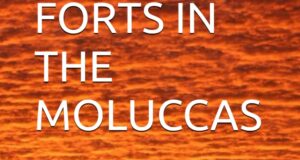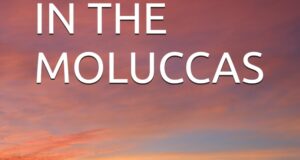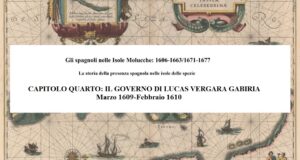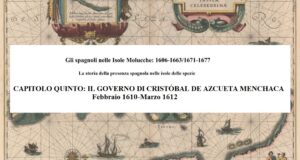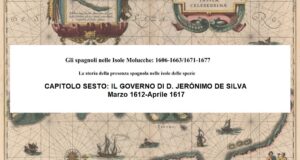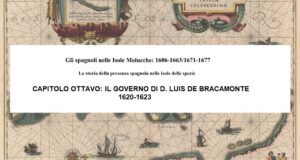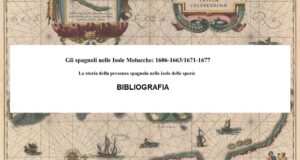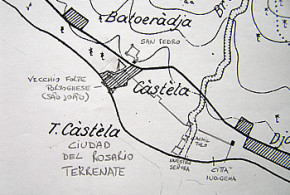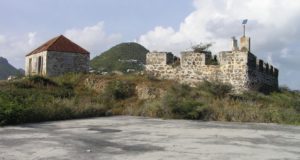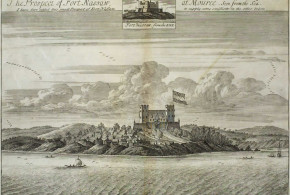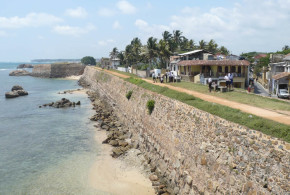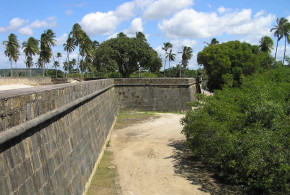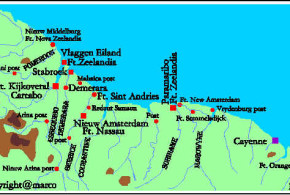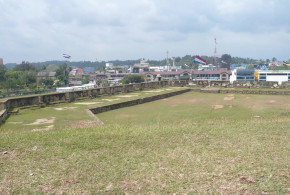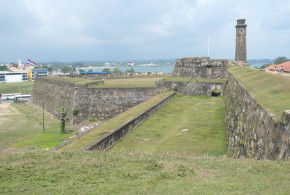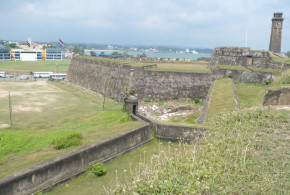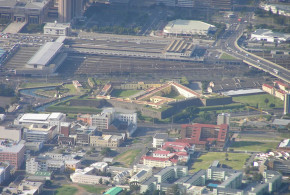Written by Marco Ramerini. English text revision by Dietrich Köster.
DUTCH EMPIRE: INDONESIA
INDONESIA:
– Various Authors, “A taste of adventure: the history of spices is the history of trade”, in: “The Economist”, 19 December 1998.
– Various Authors, “Forten, Vestingen, Redoutes, Kastelen, Blokhuis”, list of Dutch forts in Indonesia sent to me by Donald F.M. Rugebregt. – Various Authors, “Het fort Oldenbarneveld te Batjan”, in: “Eigen Haard”, (1883) 21, pp. 257-258.
– Andaya, Leonard Y., “Local Trade Networks in Maluku in the 16th, 17th, and 18th Century”, in: “Cakalele”, Volume 2/2, pp. 71-96, Maluku Research Journal, 1991, Honolulu, Hawaii, USA.
– Andaya, Leonard Y., “The world of Maluku: Eastern Indonesia in the early modern period”, University of Hawaii Press, 1993, Honolulu, Hawaii, USA.
– Andaya, Leonard, “Unravelling Minangkabau ethnicity”, in: “Itinerario”, vol. XXIV, n° 2/2000, pp. 20-43, European Journal of Overseas History, Leiden University, The Netherlands.
– Bakhuizen van den Brink, Ch.R., “De inlandsche burgers in de Molukken”, in: “BKI, 70-3/4(1915)”, pp. 595-649, ‘s-Gravenhage, 1915. Essay from ca.1880 on the population group of the so-called indigenous “Burghers” on Ambon. It was written by a government official of the Dept. of Finance in connection with the introduction of a new tax from which the indigenous “burghers” were exempted. Many references and citations from earlier literature are included, in particular from F. Valentijn. Details are given on the origin of the “Mardijkers” (liberated black slaves) and their descendants, who were brought to Ambon from the North Moluccas by the Portuguese. It is argued, in opposition to van Hoëvell (1875) and the resident of Menado, P.A. Matthes, that “Mardijkers” and “Burghers” were considered to be those, who were not in service of the V.O.C., mainly mestizos. The class of indigenous “Burghers” grew out of these burghers and the Mardijkers in the course of the 17th century. Developments during the 19th century are briefly discussed.
– Becking, C. L., “Hollandsche en Portugeesche vestigingen op het eiland Ternate”, in: “Indie GT” 8 (1924-1925) 15, pp. 235-241.
– Booth, Anne and O’Malley, W. J., “Indonesian Economic History in the Dutch Colonial Era”, 367 pp., Monograph Series, No. 35, Yale University Southeast Asia Studies, 1990.
– Blusse, Leonard, “Strange company: Chinese settlers, Mestizo women, and the Dutch in VOC Batavia”, xiii, 302p., illustrations, Foris Publications, 1986, Dordrecht-Holland and Riverton, USA.
– Das Gupta, Arun, “The maritime trade of Indonesia 1500-1800”, in: “An Expanding World”, Vol. n° 10. Prakash, Om, “European commercial expansion in early modern Asia”, pp.81-116. Also in: “India and the Indian Ocean 1500-1800”, Calcutta, 1987, pp. 240-275.
– Des Alwi & Willard Hanna, A., “Turbolent times past in Ternate and Tidore”, 290 pp. Rumah Budaya 1990, Banda Naira, Moluccas, Indonesia One of the few books that deals on early Moluccan history. Index: The Islands, the produce, the people, the first westerners; visit of the Magellan Expedition, Pigafetta’s narration; the captain, the castle, the monopoly, the de Brito tenure; the Garcias-Menezes imbroglio, the Spanish menace; tortured preliminaries to the reign of Sultan Hairun; the freakish regime of good governor Galvão; the peregrinatios and perils of Hairun; pinnacle and nadir of Hairun’s fortunes; the triumphs of Sultan Baab, the expulsion of the Portuguese; Francis Drake’s curious visit, Baab’s mysterious death; Moluccan peccadillos, Iberian fiascos; Ternatean-Tidorean-Iberian-English-Dutch confrontations; the Spanish conquest, exile of the House of Said; ascendancy of the Dutch, eclipse of the Spaniards; the deplorable Reigns of Sultan Modafar and Sultan Hamzah; the despicable Sultan Mandarsjah, tha abominable Admiral de Vlaming; the capers of Sultan Sibori: later rulers of Ternate and Tidore; protracted VOC senescence, the paradox of vast profits; M. Pierre Poivre and the purloined spice trees; troubles of the early 1790s, the gambits of Prince Nuku; the first English occupation, the levitation of spices; the second English occupation, the fate of reforms; nineteenth century personalities; glimpses of the northern Moluccas in the twentieth century.
– Diehl, K. S., “Printers and Printing in the East Indies to 1850: Batavia 1620-1850”, Aristide D. Caratzas Publications, 1990.
– Doolan, P., “Time for Dutch courage in Indonesia”, in: “History Today”, March 1997.
– Enklaar, I. H., “Joseph Kam. Apostel der Molukken…”, xv, 186 pp., “Bijdragen tot de zendingswetenschap No. 4”, 1963, ‘s-Gravenhage, The Netherlands. History of Dutch Protestant mission on the Moluccas 1815-1833, a period of renewed missionary activity, which was marked by the work of Joseph Kam.
– Goor, J. van, “Imperialisme in de marge. De afronding van Nederlands-Indië”, 322 pp., 1986, Utrecht, The Netherlands.
– Graaf, H.J., “De geschiedenis van Ambon en de Zuid-Molukken”, 304 pp., with numerous plates and illustrations, map on end papers, H. Baudet, Franeker, 1977, Wever.
– Groeneboer, Kees, “Gateway to the West: The Dutch Language in Colonial Indonesia 1600-1950. A History of Language Policy”, 400 pp. Amsterdam University Press, 1998, Amsterdam, The Netherlands. Index: Chapter 1 “The Dutch colonies of the VOC”: The language situation before the VOC; Malay as lingua franca; Portuguese as lingua franca; The language policy of the VOC; The Moluccas; Batavia; Formosa (1624-1662); Ceylon (1656-1769); Dutch under the VOC. Chapter 2 “Dutch in the nineteenth-century East Indies”: Dutch as a dying language; The Batavian, Dutch, French, and English East Indies (1800-1816); Malay as administrative language; Dutch for Europeans; European primary education; “Mother-tongue” education; Quantitative and qualitative aspects; Indo-Dutch; Dutch for the Indigenous population; European education; Dutch as the “Gateway to the West”; Dutch as a foreign language (of instruction); Quantitative and qualitative aspects; Language policy in the nineteenth century; Statistics; Dutch as language of the civil service; The struggle against Malay as official language; The Dutch language as “debt of honor”. Chapter 3 “Dutch in the twentieth-century East Indies”: More and more Dutch; Charting an “ethical course”; The General Dutch League (Algemeen Nederlands Verbond); Dutch for Europeans; “Mother-tongue” teaching; Quantitative and qualitative aspects; Indo-Dutch; Dutch for the Indigenous and Chinese population; European education; The issue of the language of instruction; Dutch as a foreign language of instruction; Dutch as a foreign language; Quantitative and qualitative aspects; Language policy up to the Second World War; Statistics; The General Dutch League; Dutch as the language of the civil service; The nationalist movement; Dutch or Malay as unifying language; A Faculty of Letters; Dutch during the Japanese occupation; Five more years of Dutch in the East Indies/Indonesia; A new language policy, 1945-1950; Statistics; Dutch and the future. Appendices: Composition of the European population group; Overview of the East Indies population; Enrollment European Primary School, 1823-1940; Dutch as language of instruction for the Indigenous and Chinese population; Dutch as language of instruction, 1900-1940: Europeans; Dutch as language of instruction; 1900-1940: Indigenous population; Dutch as language of instruction; 1900-1940: Chinese population; Numbers of boys and girls in Western Primary Education; Overview of education with Dutch as the language of instruction.
– Groeneboer, Kees, “The Dutch Language in Maluku under the VOC”, in “Cakalele”, Volume 5, pp. 1-9, Maluku Research Journal, 1994, Honolulu, Hawaii, USA.
– Hanna, Willard A., “Indonesian Banda: Colonialism and its aftermath in the nutmeg islands”, 164pp., illustrations, map, ISHI, 1978, Philadelphia, USA.
– Hyma, Albert, “A history of the Dutch in the Far East”, vi, 295pp., George Wahr Publications, 1953 (1942), Ann Arbor, Michigan, USA.
– Knaap, G. J., “Kruidnagelen en Christenen: de VOC en bevolking van Ambon 1656-1696”, xii, 323 pp., maps and illustrations, V.K.I, 1987, Dordrecht, The Netherlands.
– Knaap, G. J., “Memories van overgave van gouverneurs van Ambon in de 17e en 18e eeuw”, xxxii, 540 pp. Nijhoff, 1987, ‘s-Gravenhage, The Netherlands.
– Knaap, G. J., “Crisis and failure: war and revolt in the Ambon Islands 1636-1637”, in: “An expanding world”, vol. n° 24, “Warfare and empires”, pp. 151-176, Ashgate, Variorum, 1997 and in: “Cakalele”, Volume 3, pp. 1-26, Maluku Research Journal, 1992, Honolulu, Hawaii, USA.
– Lancker, A. F., “Het fort Koeala Kapoeas”, in: “Mars at Historia”, year 22, n°2, March/April 1988; pp. 56-59.
– Lancker, A. F., “De tragische geschiedenis van het Fort Du Bus in Lobo of Merkusoord aan de Tritonbaai, Zuidkust van Nieuw-Guinea”, in: “Mars at Historia”, year 27, n°3 July/September 1993; pp. 34-38.
– Lape, V. Peter, “Contact and colonialism in the Banda islands, Maluku, Indonesia”, Department of Anthropology, Brown University, Providence, Rhode Island, USA.
– Lape, V. Peter, “Political Factions, Trade Networks and Religious Conflict in the Late Pre-Colonial Banda Islands”, Eastern Indonesia draft of paper to be presented at the AAA Conference, Chicago Nov. 20, 1999, Department of Anthropology, Brown University, Providence, Rhode Island, USA.
– Loth, Vincent C., “Pioneers and Perkeniers: The Banda Islands in the 17th Century”, in: “Cakalele”, Volume 6, pp. 13-35, Maluku Research Journal, 1995, Honolulu, Hawaii, USA.
– Loth, Vincent C., “Armed incidents and unpaid bills: Anglo-Dutch rivalry in the Banda Islands in the seventeenth century”, Modern Asian Studies, Vol. 29 (4), pp. 705-740, 1995.
– Meilink-Roelofsz, M. A. P., “Asian Trade & European Influence in the Indonesian Archipelago between 1500 & about 1630”, 471 pp., Martinus Nijhoff, 1962, The Hague, The Netherlands. Index: I- Trade and traffic in the Indonesian Archipelago and the Malay Peninsula prior to the 15th century; II- The rise of Malacca; III- Malacca at the end of the 15th century. Structure of trade. Trade and traders in Malaccan society; IV- The commercial traffic of Malacca at the end of the 15th century: its bearing and density; V- Trade in the Indonesian Archipelago not centered exclusively on Malacca: the Sumatran ports, the spices producing areas: the Moluccas and Banda, trade in Borneo, Celebes and Lesser Sunda Islands, the Javanese seaports; VI- The influence of the Portuguese expansion on Asian trade; VII- Portuguese Malacca and native trade in the Malay-Indonesian area; VIII- The coming of the Northern Europeans to the Malay-Indonesian area, Inter-European conflicts and Asian trade; IX- The spice monopoly of the United Company and Asian trade in the Malay-Indonesian area; X- The United Company monopoly and the foreign Asian merchants in Indonesia at the beginning of the 17th century; XI- The United Company monopoly and the spice trade of the towns of Northern Java; Summary; Sources; Bibliography.
– Nas, P. J. M., “The colonial city. Yogyakarta, Palembang, Old Batavia, Mamado, Lasem”, 1997, Leiden, The Netherlands.
– Nas, P. J. M., “Miniature of Manado. Images of a peripheral settlement”, in: “Minasha Past and Present”, pp. 58-71, 1995, Leiden, The Netherlands.
– Neyens, M., “Van een oud fort en een ondeugend opschrift”, in: “TBG” 61 (1922), pp. 611-613. Article about Dutch fort Tolokko (Ternate).
– Niemeijer, H. E., “Calvinisme en koloniale stadscultuur Batavia 1619-1725”, 414 pp., illustrations, (Thesis) 1996.
– Ramerini, Marco “Le Fortezze Spagnole nell’Isola di Tidore 1521-1663” Index: 1 INTRODUZIONE. 2 I PRIMI CONTATTI DEGLI SPAGNOLI CON L’ISOLA DI TIDORE E IL PRIMO FORTE SPAGNOLO. 3 GLI AVVENIMENTI SUCCESSIVI. 4 I FORTI SPAGNOLI DELL’ISOLA DI TIDORE, 1606-1663. 5 DIFESE DELLA CITTA’ DEL RE. 5.1 Lugar Grande De El Rey (Soa Siu) 5.2 Fuerte de los Portugueses (Fortaleza dos Reis Magos). 5.3 Tohula, Santiago de los Caballeros. 5.4 Sokanora. 6 COSTA OCCIDENTALE E COSTA NORD DELL’ISOLA. 6.1 Marieco. 6.2 Marieco el Chico. 6.3 Tomanira. 6.4 Chobo. 6.5 Rume. APPENDICE: a Puli Caballo. b CAPITANI DI TIDORE (Fortezza di Santiago de los Caballeros).
– Reid, Anthony, “Southeast Asia in the Age of Commerce 1450-1680, Volume 1: The Lands Below the Winds”, Yale University Press, 1988, New Haven. – Reid, Anthony, “Southeast Asia in the Age of Commerce 1450-1680, Volume 2: Expansion and Crisis”, Yale University Press, 1993, New Haven.
– Reid, Anthony, “Southeast Asia in the Early Modern Era: Trade, Power and Belief”, Cornell University Press, 1993, Ithaca, New York, USA.
– Ricklefs, Merle, “Balance and military innovation in 17th century Java”, in: “An expanding world”, vol. n° 24, “Warfare and empires”, pp. 101-108, Ashgate, Variorum, 1997, in: “History Today”, XL, pp. 40-46, 1990, London, United Kingdom.
– Taylor Gelman, Jean, “The social world of Batavia European and Eurasian in Dutch Asia”, University of Wisconsin Press, 1983, Madison, Wisconsin & London
– Veur, Paul W. J. van der, “Introduction to a socio-political study of the Eurasians of Indonesia”, 603 pp., PhD. Thesis, Cornell University, 1955.
– Veur, Paul van der, “The Eurasians of Indonesia; a political-historical bibliography”, viii, 115 pp., Modern Indonesia Project, Cornell University, 1971, Ithaca, New York, USA.
– Villiers, John, “Trade and society in the Banda islands in the sixteenth century”, Modern Asian Studies Vol. 15 (4), pp. 723-750, 1981.
– Vlekke, B. H. M., “Nusantara. A history of the East Indian archipelago”, xv, 439 pp. 6 text-maps, 3 folding maps, 12 plates, 1945, Cambridge, Massachusetts, USA.
– van der Wall, V. I., “De Nederlandsche oudheden in de Molukken”, xx, 313 pp., with 3 folding maps and 155 illustrations on 93 plates, 1928, ‘s-Gravenhage, The Netherlands. pp. 227-275 Description of the 16th and 17th century Dutch, Portuguese and Spanish fortresses, graves, inscriptions and other monuments on the Moluccas. The monuments are described in their historical context, with emphasis on the history of the VOC.
– Winniefred, Anthonio, “Tjalie Robinson: reflections in a brown eye” ?, (Indonesia, Dutch-Eurasian), 426 pp. PhD. Thesis, University of Michigan, 1990.
– Wurffbain, Johann Sigmund, “Reise nach den Molukken und Vorder-Indien, 1632-1646, neu herausgegeben nach der zu Nürnberg im Verlag von Johann Georg Endter im Jahre 1686 erschienenen Original-Ausgabe”, 2 vols., Martinus Nijhoff, 1931, Den Haag, The Netherlands.
– Zoonen, D. van, “Drie forten bij Tijlatjap”, in: “Mars at Historia”, year 27, n°1, January/March —- 1993; pp. 33-42.
 Colonial Voyage The website dedicated to the Colonial History
Colonial Voyage The website dedicated to the Colonial History



